keystone架构分析
openstack学习报告

openstack学习报告OpenStack是一个为公有云和私有云环境提供基础设施即服务(IaaS)的开源平台。
它由计算(Nova)、网络(Neutron)、存储(Cinder)、身份认证(Keystone)、镜像(Glance)等一系列组件组成,通过这些组件,用户可以轻松地构建和管理云环境。
在本次学习报告中,我将分享我在学习OpenStack过程中所获得的知识和体会。
首先,我学习了OpenStack的基本架构和组件。
OpenStack采用了分布式架构,其中控制节点负责管理整个云环境,包括计算、网络和存储资源的分配和调度,而计算节点、网络节点和存储节点则负责提供实际的资源。
这种架构使得OpenStack具有高可扩展性和高可用性的特点。
在学习OpenStack的过程中,我也遇到了一些挑战。
首先,OpenStack的架构和组件非常复杂,需要对网络和存储等概念有一定的了解才能够理解和应用。
其次,部署和配置OpenStack也需要一定的技术和经验,包括网络设置、安全设置和性能调优等。
此外,OpenStack的发展非常迅猛,每个版本都有新的功能和改进,需要不断地学习和跟进。
然而,学习OpenStack也带给我很多收获。
首先,我深入了解了云计算的原理和技术,对分布式计算和虚拟化有了更深入的了解。
其次,我学会了使用OpenStack构建和管理云环境,这为我日后的工作提供了重要的技能和经验。
最后,通过学习OpenStack,我也认识到了开源软件的力量和价值,它可以帮助我们解决实际的问题,促进技术的发展和创新。
总结起来,学习OpenStack是一项有挑战但也非常有意义的任务。
通过学习OpenStack,我不仅扩展了自己的知识和技能,还了解了最新的云计算技术和趋势。
我相信,在日后的工作和学习中,我会继续深入研究OpenStack,并将其应用到实际的项目中,为组织和用户提供更好的云服务。
DSP在雷达方面的应用

DSP在雷达方面的应用摘要:DSP是一种基于精简指令集的可编程数学计算芯片,可以对数字信号进行时频域变换、频谱分析、滤波、估值、增强、压缩等处理,广泛应用于家用电器、多媒体系统、雷达、卫星系统、移动通信、网络会议、医学仪器、实时图像识别与处理、语音处理、自适应制导控制、模式识别、定位、导航、联合战术无线电系统和智能基站等领域。
本文重点介绍通用DSP在雷达信号处理系统中的典型应用,以及研制基于DSP的雷达信号处理系统的关键技术。
关键词:DSP,军事,雷达;一、多核DSP在军事应用随着无人机(UAV)、声纳、雷达、信号情报(SIGINT)以及软件定义无线电(SDR) 等波形密集型应用中的信号处理需求不断攀升,多个数字信号处理器(DSP)内核的使用已成为重要的实现手段。
多核功能与不断丰富的IP内核及开发工具相结合可实现优异的系统架构。
所有这些应用都需要多核DSP来满足关键任务行业的各种需求,其中包括更强大的功能性(更快的处理速度)、更精细的分辨率以及更高的精度。
过去,处理器性能的改善是通过工艺节点升级及提高运行时钟频率来实现的。
然而,发展小型工艺节点和提高时钟频率并不是提高性能的低功耗捷径。
在单个裸片中集成多核的这个方法可在更低的时钟频率及功耗下实现所需的高性能。
当前的多核器件或采用同质内核,即所有处理内核都是相同的;或采用异质内核,即器件由不同类型的内核组成。
几乎所有应用都需要混合搭配的处理功能来满足行业需求。
从开发人员角度看,重点是支持同质内核,因为异质系统架构可通过同质器件创建。
反之,如果不牺牲性能就很难实现。
图1(下图)是作为异质多核架构实例的德州仪器 (TI) KeyStone 多核架构。
图1:德州仪器KeyStone多核架构TI KeyStone多内核架构拥有高度的灵活性,可同时集成定点与浮点运算、定向协处理与硬件加速,以及优化的内核间/组件间通信。
此架构包括多个 C66x DSP 内核,能够支持高达 256 GMAC 的定点运算性能以及 128GFLOP 的浮点运算性能。
OpenStack云计算平台实战(微课版)-期末试卷(A)答案[4页]
![OpenStack云计算平台实战(微课版)-期末试卷(A)答案[4页]](https://img.taocdn.com/s3/m/db2b981d86c24028915f804d2b160b4e767f8187.png)
xx 大学20xx ~20xx 学年第x 学期班 OpenStack 云计算期末考试试卷(闭卷)(A 卷)参考答案及评分标准一、单项选择题(每小题2分,共30分)二、简答题(每小题5分,共50分) 1、简述云计算架构。
云计算架构包括3个层次的服务:(1)基础设施即服务(IaaS )。
将数据中心、基础设施等硬件资源通过Internet 分配给用户,提供的服务是虚拟机。
(2)平台即服务(PaaS )。
将一个完整的计算机平台,包括应用设计、应用开发、应用测试和应用托管,都作为一种服务提供给客户。
(3)软件即服务(SaaS )。
用户无须购买和安装软件,而是直接通过网络向专门的提供商获取自己所需要的、带有相应软件功能的服务。
2、OpenStack 组件间之间是如何通信的?OpenStack 组件之间通过以下4种方式进行通信。
(1)基于AMQP 协议。
AMQP 是高级消息队列协议,用于每个项目内部各个组件之间的通信。
装 订 线(2)基于SQL的通信。
通过数据库连接实现的通信大多用于各个项目内部,不要求数据库和项目其他组件安装在同一个节点上。
(3)基于HTTP协议进行通信。
各项目之间通过API建立通信关系,这些API 都是RESTful Web API。
(4)通过Native API实现通信。
OpenStack各组件和第三方软硬件之间采用这种通信方式。
3、OpenStack的物理网络有哪些类型?OpenStack环境中的物理网络可划分为外部网络、管理网络、API网络和数据网络等。
4、Keystone主要有哪些功能?Keystone主要功能包括身份认证、用户授权、用户管理和服务目录。
5、OpenStack是如何分配角色的?OpenStack通常将该角色分配给“用户—项目”对,也就是为某个项目的指定用户分配角色。
也可以为整个系统或某个域的指定用户分配角色。
6、什么是cloud-init?其主要作用有哪些?cloud-init是一组Python脚本的集合,是一个能够定制云镜像的实用工具。
OpenStack入门

OpenStack入门之基本组件写在前面OpenStack 核心的项目:Nova 、 Cinder、 Neutron、 Swift、 Keystone、 Glance、 Horizon1. Nova又被称为 OpenStack Compute,主要作用是控制虚拟机的创建,以及改变它的容量和配置,还可以做虚拟机的销毁,虚拟机的整个生命周期都是由 Nova 来控制的;Nova的部署运行一般有两种情况:一类是 Nova 作为 Controller 节点去运行,Controller 节点是用来控制其它的一些计算节点的;另外一类节点就是Compute 节点,是计算节点,上面是运行实际的虚拟机的;那么有什么区别呢?∙在 Compute 节点上部署的 Nova,它上面核心运行的一个东西叫作 Nova Compute,主要是为了去对虚拟机进行控制,它去和 Hypevisor 进行交互,对虚拟机进行控制;∙在 Controller 上运行的 Nova 就相对复杂一些,它有 Scheduler、Conductor、Nova Cell;∙Scheduler 在用户发起请求的时候决定这个虚拟机应该在哪个机器上启动,应该在哪个计算节点上启动;∙Conductor 是对所有的计算节点进行一个统一的管理;∙Nova Cell 的作用是级联控制虚拟机的生命周期控制节点:Scheduler(决定虚拟机的启动位置)、Conductor(对所有的计算节点进行统一管理)、Nova Cell(级联)计算节点:对虚拟机进行控制2. CinderCinder 组件主要的用途是提供块存储服务,最核心的两个部分是Scheduler 和Cinder Volume。
有读写存储服务请求的时候,Schduler决定通过哪个Cinder Volume进行读取操作,Cinder Volume是实际控制存储的设备3. Neutron有一个非常火的一个概念叫作SDN,软件定义网络,在OpenStack里边的一个实现,Neutron 有一个很大的特点就是提供Plugin模块,这个是用户可以自己去写的。
keystone架构分析

Keystone基本概念介绍1. UserUser即用户,他们代表可以通过keystone进行访问的人或程序。
Users通过认证信息(credentials,如密码、API Keys等)进行验证。
2. TenantTenant即租户,它是各个服务中的一些可以访问的资源集合。
例如,在Nova 中一个tenant可以是一些机器,在Swift和Glance中一个tenant可以是一些镜像存储,在Quantum中一个tenant可以是一些网络资源。
Users默认的总是绑定到某些tenant上。
3. RoleRole即角色,Roles代表一组用户可以访问的资源权限,例如Nova中的虚拟机、Glance中的镜像。
Users可以被添加到任意一个全局的或租户内的角色中。
在全局的role中,用户的role权限作用于所有的租户,即可以对所有的租户执行role规定的权限;在租户内的role中,用户仅能在当前租户内执行role 规定的权限。
4. ServiceService即服务,如Nova、Glance、Swift。
根据前三个概念(User,Tenant 和Role)一个服务可以确认当前用户是否具有访问其资源的权限。
但是当一个user尝试着访问其租户内的service时,他必须知道这个service是否存在以及如何访问这个service,这里通常使用一些不同的名称表示不同的服务。
在上文中谈到的Role,实际上也是可以绑定到某个service的。
例如,当swift需要一个管理员权限的访问进行对象创建时,对于相同的role我们并不一定也需要对nova进行管理员权限的访问。
为了实现这个目标,我们应该创建两个独立的管理员role,一个绑定到swift,另一个绑定到nova,从而实现对swift进行管理员权限访问不会影响到Nova或其他服务。
5. EndpointEndpoint,翻译为“端点”,我们可以理解它是一个服务暴露出来的访问点,如果需要访问一个服务,则必须知道他的endpoint。
5G考试题
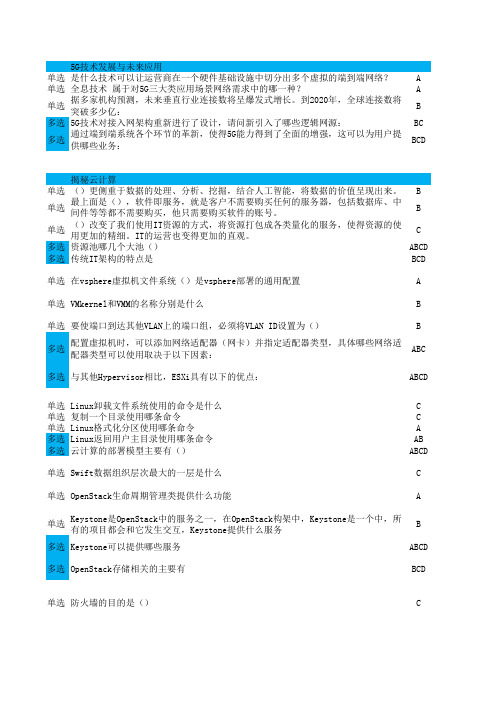
ABCD
多选 一般所指的虚拟化资源包括()和()
CD
单选
对ESXi的管理有2种方式,使用vsphere client直接管理esxi主机和使用vcenter server来管理,vsphere client和vcenter Server分别访问ESXi的什么服务
A
单选 关于迁移下列说法不正确的是
D
A D A ABCD ABCD
单选 Python中以双下线开头的标识符代表什么 单选 shell脚本中如何获取文件的最后一行 单选 SaltStack是基于什么语言开发 多选 关于自动化运维说法正确的是
多选 运维自动化应包括上述这些内容
A B D ABCD
ABC
单选
边缘计算的主题是多个分布式部署的边缘节点,主要包括边缘基础设施、()和边 缘云三部分。
ACD
单选 Linux内核最早是由谁开发的
D
单选 ()技术将多个单独的物理硬盘以不同的方式组个成一个逻辑硬盘,从而提高
D
单选 Linux返回根目录使用哪条命令
D
探索大数据和人工智能
单选 以下哪个属于大数据在电信行业的数据商业化方面的应用?
A
单选 以下哪个不属于大数据在电信行业的应用?
B
单选 下列选项中,不是用于数据存储的技术是哪一个?
单选 以下说法错误的是()
B
单选 ()需要手工配置路由条目,不能感知网络的情况
A
单选 ()是指从源到目的地经过所有链路的开销的总和
A
多选 以下说法正确的是()
AB
多选 以下是NAT的工作方式的是()
ABC
单选 Docker容器解决可配额/可度量问题采用的技术是()
keystone介绍
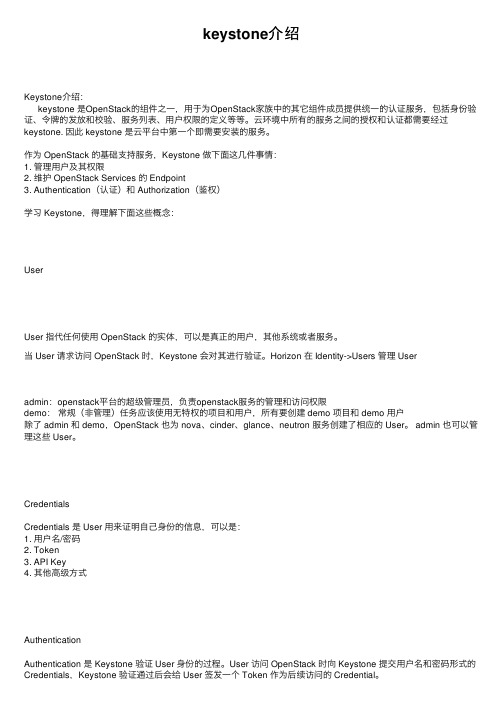
keystone介绍Keystone介绍:keystone 是OpenStack的组件之⼀,⽤于为OpenStack家族中的其它组件成员提供统⼀的认证服务,包括⾝份验证、令牌的发放和校验、服务列表、⽤户权限的定义等等。
云环境中所有的服务之间的授权和认证都需要经过keystone. 因此 keystone 是云平台中第⼀个即需要安装的服务。
作为 OpenStack 的基础⽀持服务,Keystone 做下⾯这⼏件事情:1. 管理⽤户及其权限2. 维护 OpenStack Services 的 Endpoint3. Authentication(认证)和 Authorization(鉴权)学习 Keystone,得理解下⾯这些概念:UserUser 指代任何使⽤ OpenStack 的实体,可以是真正的⽤户,其他系统或者服务。
当 User 请求访问 OpenStack 时,Keystone 会对其进⾏验证。
Horizon 在 Identity->Users 管理 Useradmin:openstack平台的超级管理员,负责openstack服务的管理和访问权限demo:常规(⾮管理)任务应该使⽤⽆特权的项⽬和⽤户,所有要创建 demo 项⽬和 demo ⽤户除了 admin 和 demo,OpenStack 也为 nova、cinder、glance、neutron 服务创建了相应的 User。
admin 也可以管理这些 User。
CredentialsCredentials 是 User ⽤来证明⾃⼰⾝份的信息,可以是:1. ⽤户名/密码2. Token3. API Key4. 其他⾼级⽅式AuthenticationAuthentication 是 Keystone 验证 User ⾝份的过程。
User 访问 OpenStack 时向 Keystone 提交⽤户名和密码形式的TokenToken 是由数字和字母组成的字符串,User 成功 Authentication 后 Keystone ⽣成 Token 并分配给 User。
《云计算》B卷及答案

《云计算》课程试卷B卷一、单项选择题(共10小题,每题2分,共20分)1、IaaS是()的简称。
A. 软件即服务B. 平台即服务C. 基础设施即服务D. 硬件即服务2、下列不属于Google云计算平台技术架构的是()A. 并行数据处理MapReduceB. 分布式锁ChubbyC. 结构化数据表BigTableD. 弹性云计算EC23、云计算的一大特征是(),没有高效的网络云计算就什么都不是,就不能提供很好的使用体验。
A. 按需自助服务B. 无处不在的网络接入C. 资源池化D. 快速弹性伸缩4、Keystone是OpenStack中的服务之一。
在OpenStack架构中,Keystone是一个中心,所有的项目都会和它发生交互,Keystone提供()服务。
A. 存储服务B. 认证服务C. 计算服务D. 网络服务5、虚拟化技术是将一台物理形态计算机虚拟成多台()。
A. 逻辑形态计算机B.逻辑单元C. 逻辑形态服务器D.块状形态计算机6、2010年8月,上海于推出了(),积极推动云计算产业的创新发展,并推进多个云计算示范项目率先落地,突破云计算应用的难题。
A. “天云计划”B. “祥云工程”C. “云海计划”D. “云端计划”7、以下不是云安全主要考虑的核心技术的是()A. Web信誉服务B. 行为关联分析技术C. 自动反馈机制D. 服务器安全8、BigTable属于哪种技术()A. 分布式计算B. 分布式存储C. 云计算D. 网格计算9、下面关于全虚拟化技术描述不正确的是()A. 也称为原始虚拟化技术B. 指虚拟机模拟了完整的底层硬件C. 使得为原始硬件设计的操作系统或其它系统软件完全不做任何修改就可以在虚拟机中运行D. 虚拟机发出的指令无需经过Hypervisor捕获并处理10、我国政府高度重视云计算产业发展,所制定的政策主要秉承()的理念。
A. “促进为主、重视安全”B. “统一标准,安全监测”C. “政策引导,国家投资和私人资本结合”D. “云优先”二、判断题(共5小题,每题2分,共10分)1、云计算模式中用户不需要了解服务器在哪里,不用关心内部如何运作,通过高速互联网就可以透明地使用各种资源。
《云计算》B卷及答案

《云计算》课程试卷B卷一、单项选择题(共10小题,每题2分,共20分)1、IaaS是()的简称。
A. 软件即服务B. 平台即服务C. 基础设施即服务D. 硬件即服务2、下列不属于Google云计算平台技术架构的是()A. 并行数据处理MapReduceB. 分布式锁ChubbyC. 结构化数据表BigTableD. 弹性云计算EC23、云计算的一大特征是(),没有高效的网络云计算就什么都不是,就不能提供很好的使用体验。
A. 按需自助服务B. 无处不在的网络接入C. 资源池化D. 快速弹性伸缩4、Keystone是OpenStack中的服务之一。
在OpenStack架构中,Keystone是一个中心,所有的项目都会和它发生交互,Keystone提供()服务。
A. 存储服务B. 认证服务C. 计算服务D. 网络服务5、虚拟化技术是将一台物理形态计算机虚拟成多台()。
A. 逻辑形态计算机B.逻辑单元C. 逻辑形态服务器D.块状形态计算机6、2010年8月,上海于推出了(),积极推动云计算产业的创新发展,并推进多个云计算示范项目率先落地,突破云计算应用的难题。
A. “天云计划”B. “祥云工程”C. “云海计划”D. “云端计划”7、以下不是云安全主要考虑的核心技术的是()A. Web信誉服务B. 行为关联分析技术C. 自动反馈机制D. 服务器安全8、BigTable属于哪种技术()A. 分布式计算B. 分布式存储C. 云计算D. 网格计算9、下面关于全虚拟化技术描述不正确的是()A. 也称为原始虚拟化技术B. 指虚拟机模拟了完整的底层硬件C. 使得为原始硬件设计的操作系统或其它系统软件完全不做任何修改就可以在虚拟机中运行D. 虚拟机发出的指令无需经过Hypervisor捕获并处理10、我国政府高度重视云计算产业发展,所制定的政策主要秉承()的理念。
A. “促进为主、重视安全”B. “统一标准,安全监测”C. “政策引导,国家投资和私人资本结合”D. “云优先”二、判断题(共5小题,每题2分,共10分)1、云计算模式中用户不需要了解服务器在哪里,不用关心内部如何运作,通过高速互联网就可以透明地使用各种资源。
云计算基础架构平台构建与应用-2019课程标准

《云计算基础架构平台构建与应用》2019课程标准目录一、课程定位与内容概括 (1)二、课程目标 (1)(一)总体目标 (1)(二)分类目标 (1)三、课程内容与要求 (2)(一)教学软件的版本要求: (3)(二)教学设计与评价 (4)(三)课程模块与要求 (4)四、课程实施的建议 (6)五、推荐教材和教学资源 (7)(一)推荐教材 (7)(二)课程资源的开发与利用 (7)六、课程标准说明 (7)《云计算基础架构平台构建与应用》课程标准一、课程定位与内容概括建议学时:56课时(两周实训课)适用专业: 云计算技术与应用,云计算技术,以及计算机专业群中其他专业。
本课程是云计算技术与应用专业,云计算技术专业的岗位能力课程,专业核心课程。
课程也可根据实际需要用于计算机专业群中其他相关专业的人才培养计划中。
课程以云计算Openstack技术为主要内容,详细讲解与介绍了Openstack技术的基本原理和实战操作;同时课程中的内容为云计算/云计算运维工程师,以及云计算/大数据开发工程师在生产环境中工作所必备的最重要最常用的基础内容;课程内容按模块划分,不同模块中理论与操作实践相结合,形成了基于云计算技术的知识技能的体系结构。
本课程建议大二开设,开设本课程前,学生应该具备一定的Linux操作系统基础(基于centos7.2以上版本),以及一定的网络基础知识。
本课程中内容可以直接为学生进一步学习后续课程(例如:Docker 容器虚拟化技术,云计算产品开发,以及云计算产品部署等)以及今后学生的就业打下坚实的基础。
课程内容也可以更具院校课时要求或教学要求横向纵向扩展。
二、课程目标(一)总体目标通过本课程的学习,学生能够了解Openstack技术的相关知识,包括云计算技术概况,云计算技术的分类,Openstack项目的概况,Openstack搭建的相关内容,如何通过Openstack命令进行基本的运维管理,Keystone对平台的权限管理,Glance镜像服务构建虚拟系统,Nova计算服务管理云主机生命周期,Neutron网络服务实现网络通信,Cinder块存储服务通过多种后端驱动提供数据磁盘,Swift提供对象存储,Horizon图形化方式调用API资源等等。
openstack组件作用介绍

1.控制节点负责对其余节点的控制,包含虚拟机创建、迁移、网络分配、存储分配等等控制节点架构:控制节点包括以下服务管理支持服务基础管理服务扩展管理服务1)管理支持服务包含数据库与消息代理服务数据库作为基础/扩展服务产生的数据存放的地方消息代理服务(也称消息中间件)为其他各种服务之间提供了统一的消息通信服务2)基础管理服务包含Keystone、Glance、Nova、Neutron、Horizon五个服务Keystone:认证管理服务、提供了其余所有组件的认证信息/令牌的管理、创建、修改等等、使用MySQL等数据库存储认证信息Glance:镜像管理服务,提供了对虚拟机部署的时候所能提供镜像的管理、包含镜像的导入、格式以及制作相应的模板Nova:计算管理服务,提供了对计算节点的Nova管理、使用Nova-API进行通信Neutron:网络管理服务、提供了对网络节点的网络拓扑管理,同时提供Neutron 在Horizon的管理界面Horizon:控制台服务,提供了以Web形式对所有节点的所有服务的管理,通常把该服务成为Dashboard3)扩展管理服务包含Cinder、Swift、Trove、Heat、Centimeter五个服务Cinder:提供管理存储节点的Cinder相关、同时提供Cinder在Horizon中的管理面板Swift:提供管理存储节点Swift相关、同时提供Swift在Horizon中的管理面板Trove:提供管理数据库节点的Trove先关、同时提供Trove在Horizon中的管理面板Heat:提供了基于模板来实现云环境中的资源的初始化,依赖关系处理,部署等基本操作,也可以解决自动收缩、负载均衡等高级特性Centimeter:提供对物理资源以及虚拟资源的监控,并记录这些书库,读数据进行分析,在一定条件下出发现货供应动作控制节点通常来说只需要一个网络端口来用于通信和管理各个节点2.计算节点负责虚拟机运行计算节点架构计算节点包含Nova、Neutron、Telemter三个服务1)基础服务Nova:提供虚拟机的创建、运行、迁移、快照等围绕虚拟机的服务、并提供API 与控制节点对接、由控制节点下发任务Neutron:提供计算节点与网络节点之间的通信2)扩展服务Telmeter:提供计算节点监控代理、将虚拟机的情况反馈的控制节点,是Centimeter 的代理服务计算节点包含最少两个网络端口端口1:与控制节点进行通信,受控制节点统一调配端口2:与网络节点,存储节点进行通信3.网络节点负责对外网络与内网之间的通信网络节点架构网络节点仅包含Neutron服务Neutron:负责管理私有网络与公有网络的通信,以及管理虚拟机网络之间通信/拓扑、管理虚拟机之上的防火墙等等网络节点包含三个网络端口端口1:用于与控制节点进行通信端口2:用于除了控制节点之外的计算/存储节点之间的通信端口3:用于外部的虚拟机与相应的网络之间通信4.存储节点负责对虚拟机的额外存储管理等等存储节点架构存储节点包含Cinder,Swift等服务Cinder:块存储服务,提供相应的块才能出,简单来说,就是虚拟出一块存盘,可以挂载到相应的虚拟机之上,不收文件系统的影响,对虚拟机来说,这个操作像是加了一块硬盘,可以完成对磁盘的任何操作,包括挂载、卸载、格式化,转换文件系统等等操作,大多应用于虚拟机空间不足的情况下的空间扩容等。
OpenStack云平台核心模块详解
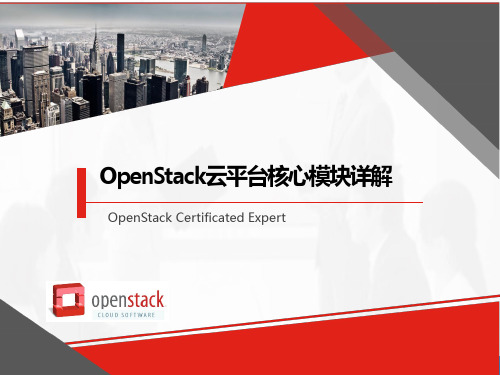
• nova-consoleauth:为vnc代理服务器提供token验证服务 • nova-novncproxy:为浏览器和vncserver之间建立socket,
console用来连接到虚机的console接口,实现基于vnc的登录和操作 • nova-cert:对接EC2-API的时候才使用,为euca-bundle-image提
backend,可在配置文件glance-api.conf中定义
Horizon
CLI
Nova
File System
Glance-API Storage Adapter
Glance Backend
Swift Cinder
Glance-Registry Glance-DB
Ceph RBD Sheepdog Amazon S3
• 服务相关
• service(服务):OpenStack 服务,如nova、neutron等,每个服务提供一个或者多个 endpoint 供用户访问 资源以及进行操作
• endpoint(端点):endpoint是一个网络上可访问的地址,通常是URL。service 通过 endpoint 暴露自己的 API,每个Service有public、internal、admin三个endpoint,keystone 负责管理和维护每个 Service 的 Endpoint
Keystone
• 用户相关
• domain(域) • project(项目) • user(用户) • group(用户组) • role(角色) • token(令牌)
• 一个Region中可以包含多个Domain,一个Domain中可以包含多个Group、user和Project,一个Group中可以包 含多个user。
简述openstack架构工作流程

简述openstack架构工作流程下载温馨提示:该文档是我店铺精心编制而成,希望大家下载以后,能够帮助大家解决实际的问题。
文档下载后可定制随意修改,请根据实际需要进行相应的调整和使用,谢谢!并且,本店铺为大家提供各种各样类型的实用资料,如教育随笔、日记赏析、句子摘抄、古诗大全、经典美文、话题作文、工作总结、词语解析、文案摘录、其他资料等等,如想了解不同资料格式和写法,敬请关注!Download tips: This document is carefully compiled by theeditor.I hope that after you download them,they can help yousolve practical problems. The document can be customized andmodified after downloading,please adjust and use it according toactual needs, thank you!In addition, our shop provides you with various types ofpractical materials,such as educational essays, diaryappreciation,sentence excerpts,ancient poems,classic articles,topic composition,work summary,word parsing,copy excerpts,other materials and so on,want to know different data formats andwriting methods,please pay attention!深入理解OpenStack架构的工作流程OpenStack是一个开源的云计算平台,用于构建和管理私有云、公有云以及混合云。
2019云计算技术与应用赛题库
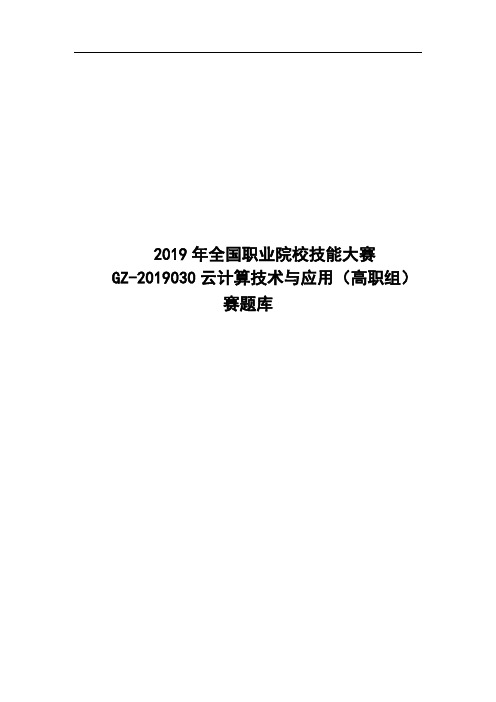
2019年全国职业院校技能大赛GZ-2019030云计算技术与应用(高职组)赛题库第一部分:IaaS云计算基础架构平台任务一、IaaS云平台搭建基础环境:① 1.使用命令行方式设置主机名,防火墙以及SELinux设置如下:(1)设置控制节点主机名controller;计算节点主机名:compute。
(2)各个节点关闭防火墙,设置开机不启动。
(3)设置各个节点selinux状态为permissive。
② 2.使用命令查询控制/计算节点的主机名。
③ 3.使用命令查询控制/计算节点selinux的状态。
④ 4.在控制节点上通过SecureFX上传两个镜像文件CentOS-7-x86_64-DVD-1511.iso,XianDian-IaaS-v2.2.iso到opt下,使用命令创建/opt下两个目录,并将以上镜像文件分别挂载到上述两个目录下,并使用命令查看挂载的情况(需显示挂载的文件系统类型和具体的大小)。
⑤ 5.在控制节点上通过SecureFX上传两个镜像文件CentOS-7-x86_64-DVD-1511.iso,XianDian-IaaS-v2.2.iso到opt下,通过命令行创建两个目录,并将以上镜像文件分别挂载到上述两个目录下。
⑥ 6.配置控制节点本地yum源文件local.repo ,搭建ftp服务器指向存放yum源路径;配置计算节点yum源文件ftp.repo使用之前配置的控制节点ftp作为yum源,其中的两个节点的地址使用主机名表示。
使用cat命令查看上述控制/计算节点的yum源全路径配置文件。
⑦7.在控制节点和计算节点分别安装iaas-xiandian软件包,完成配置文件中基本变量的配置,并根据提供的参数完成指定变量的配置。
Mysql搭建:⑧ 1.根据平台安装步骤安装至数据库服务,使用一条命令安装提供的iaas-install-mysql.sh脚本并查看脚本运行的时间。
⑨ 2.使用root用户登录数据库,查询数据库列表信息。
openstack原理
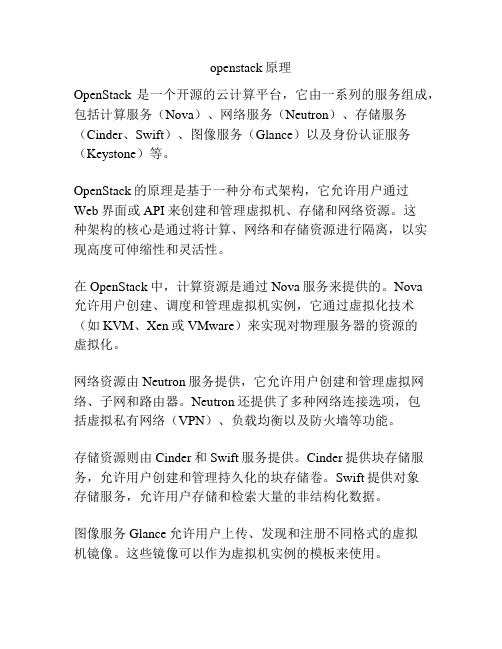
openstack原理OpenStack是一个开源的云计算平台,它由一系列的服务组成,包括计算服务(Nova)、网络服务(Neutron)、存储服务(Cinder、Swift)、图像服务(Glance)以及身份认证服务(Keystone)等。
OpenStack的原理是基于一种分布式架构,它允许用户通过Web界面或API来创建和管理虚拟机、存储和网络资源。
这种架构的核心是通过将计算、网络和存储资源进行隔离,以实现高度可伸缩性和灵活性。
在OpenStack中,计算资源是通过Nova服务来提供的。
Nova允许用户创建、调度和管理虚拟机实例,它通过虚拟化技术(如KVM、Xen或VMware)来实现对物理服务器的资源的虚拟化。
网络资源由Neutron服务提供,它允许用户创建和管理虚拟网络、子网和路由器。
Neutron还提供了多种网络连接选项,包括虚拟私有网络(VPN)、负载均衡以及防火墙等功能。
存储资源则由Cinder和Swift服务提供。
Cinder提供块存储服务,允许用户创建和管理持久化的块存储卷。
Swift提供对象存储服务,允许用户存储和检索大量的非结构化数据。
图像服务Glance允许用户上传、发现和注册不同格式的虚拟机镜像。
这些镜像可以作为虚拟机实例的模板来使用。
最后,Keystone是OpenStack的身份认证服务,它充当用户身份验证和授权的中心。
Keystone使用安全令牌来验证用户的身份,并控制用户对各个OpenStack服务的访问权限。
综上所述,OpenStack的原理是通过将计算、网络和存储资源进行分离和虚拟化,提供用户灵活且可伸缩的云计算环境。
每个服务都有自己的功能,并通过API进行通信,以实现各种云计算需求。
基于创龙TMS320C6678 DSP+ Xilinx Kintex-7 FPGA工业核心板简介

2 典型运用领域
视频通信系统
电力采集 雷达声纳 光缆普查仪 医用仪器 机器视觉
3 软硬件参数
硬件框图
硬件参数
表 1 DSP 端硬件参数 CPU TMS320C6678,8 核 C66x,主频 1.0/1.25GHz
CPU 主频 1.0GHz/核 1.0GHz/核 1.0GHz/核 1.0GHz/核 1.25GHz/核 1.25GHz/核 1.25GHz/核 1.25GHz/核
表7 NAND FLASH
128MByte 128MByte 128MByte 128MByte 128MByte 128MByte 128MByte 128MByte
广州创龙结合 TI KeyStone 系列多核架构 TMS320C6678 及 Xilinx Kintex-7 系列 FPGA 设计的 SOM-TL6678F 核心板是一款 DSP+FPGA 高速大数据采集处理平台,采用沉金无铅 工艺的 14 层板设计,专业的 PCB Layout 保证信号完整性的同时,经过严格的质量控制, 满足多种环境应用。
表5 典型值电流
800mA
典型值功耗 7.47W
6 机械尺寸图
PCB 尺寸 安装孔数量 散热器安装孔数量
表6 112mm*75mm 4个 4个
7 产品订购型号
型号
SOM-TL6678F-1000/325T1GN-8/4GD-I
SOM-TL6678F-1000/325T1GN-8/8GD-I
SOM-TL6678F-1000/325T1GN-16/4GD-I
3.1keystone管理认证用户
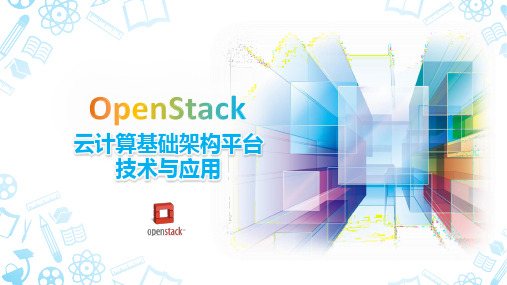
1
keystone管理认证用户
管理认证用户
绑定用户和租户权限
从上面操作可以看出,绑定用户权限需要用户名称、角色名称和租户名称 等信息。具体命令格式如下:
$keystone user-role-add --user <user> --role <role> [-tenant <tenant>]
1
keystone管理认证用户
[--description <tenant-description>] [--enabled <true|false>]
1
keystone管理认证用户
管理认证用户
创建角色
角色限定了用户的操作权限。如下创建一个角色“compute-user”:
$keystone role-create --name=compute-user 从上面操作可以看出创建角色需要角色名称信息。具体命令格式如下: $keystone role-create --name <role-name>
1
keystone管理认证用户
相关概念
租户(Tenant)
Tenant即租户,早期版本又称为project,它是 各个服务中的一些可以访问的资源集合。比如 通过nova创建虚拟机时要指定到某个租户中, 在cinder创建卷也要指定到某个租户中,用户 访问租户的资源前,必须与该租户关联,并且 指定该用户在该租户下的角色。
管理认证用户
图形化用户管理
图形化界面操作
以管理员身份登录到 dashboard,进入“管 理员/认证面板/项目” 可以看到项目(租户) 列表如图所示。
1
keystone管理认证用户
揭秘云计算——精选推荐

ABCD1、()更侧重于数据的处理、分析、挖掘,结合人工智能,将数据的价值呈现出来。
(B)A.云计算B.大数据C.人工智能D.物联网2、最上面是(),软件即服务,就是客户不需要购买任何的服务器,包括数据库、中间件等等都不需要购买,他只需要购买软件的账号。
(B)A.PaaSB.SaaSC.IaaSD.DCaaS3、()改变了我们使用IT资源的方式,将资源打包成各类量化的服务,使得资源的使用更加的精细。
IT的运营也变得更加的直观。
(C)A.简单化B.平台化C.服务化D.专一化1、资源池哪几个大池()(ABCD)A.计算B.存储C.网络D.安全2、传统IT架构的特点是BCDA.解耦合B.竖井C.封闭D.耦合1、qemu-kvm是QEMU和KVM的结合,指用户态()模拟器+ 内核态()模块所构成的一套完整的虚拟化平台(A)A.qemu、kvmB.kvm、qumuC.quem、vmwareD.kem、vmware2、关于迁移下列说法不正确的是(D)A.冷迁移:可将已关闭电源或已挂起的虚拟机移至新主机B.热迁移:对正处于开启状态的虚拟机进行迁移 C.热迁移分为vMotion和Storage vMotion D.Storage vMotion是将虚拟机内部的数据进行迁移3、要使端口组到达其他VLAN上的端口组,必须将VLAN ID设置为( B)A.80B.4095C.8080D.33061、VMkernel专用于支持运行多个虚拟机及提供如下核心功能ABCA.资源调度B.I/O堆栈C.设备驱动程序D.管理界面2、配置虚拟机时,可以添加网络适配器(网卡)并指定适配器类型,具体哪些网络适配器类型可以使用取决于以下因素:ABCA.虚拟机版本B.虚拟机是否已更新到当前主机的最新版本C.客户机操作系统D.主机操作系统1、Linux中只能修改文件的组属性使用哪条命令 CA.mkdirB.chmodC.chgrpD.chown2、Linux挂载文件系统使用什么命令CA.fdiskB.mkfsC.mountD.unmount3、关于ifconfig下列说法不正确的是CA.ifconfig可以进行网络接口配置B.ifconfig可以查看当前ip地址C.ifconfig使用后需要重启才能生效D.ifconfig所有的配置都是应用于内核的1、Linux在企业中的应用(ABCD)A.Linux作为Internet网络服务器的应用B.Linux作为中小企业内部服务器的应用C.Linux作为桌面环境的应用D.Linux作为软件开发环境的应用2、以下说法正确的是(ABCD)A./dev包含所有设备的特定设备文件B./lib root文件系统上的程序所需的共享库C./etc存放机器专用的配置文件D./usr用于存放系统的程序1、OpenStack包含两个主要模块:()和() BA.nava和swiftB.nova和swiftC.Manila和NeutronD.Octavia和Ironic2、Keystone是OpenStack中的服务之一,在OpenStack架构中,Keystone是一个中心,所有的项目都会和它发生交互,Keystone提供什么服务BA.存储服务B.认证服务C.计算服务D.网络服务3、Cinder的调度器Cinder-Scheduler通过两个步骤选择合适的存储节点,这两步中第一步是(),第二步是权重计算(weighting)BA.随机选择(random)B.过滤器(filter)C.选举(election)D.投票(vote)1 Swift的总体架构分为2层,分别是访问层(Access Tier)和存储层(Capacity Tier),访问层提供什么服务(ABCD)A.代理服务B.认证服务C.缓存服务D.哈希环2、OpenStack系统的部署架构,一般称为三种网络和四种节点,四种结点不包括下列哪种结点(CD)A.计算节点B.控制节点C.监测节点D.通讯节点1、访问列表是由()命令生成的。
keystone 基本架构
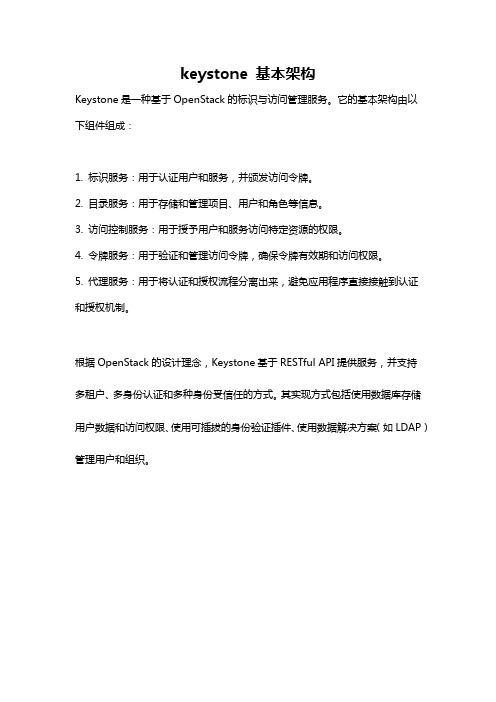
keystone 基本架构
Keystone是一种基于OpenStack的标识与访问管理服务。
它的基本架构由以下组件组成:
1. 标识服务:用于认证用户和服务,并颁发访问令牌。
2. 目录服务:用于存储和管理项目、用户和角色等信息。
3. 访问控制服务:用于授予用户和服务访问特定资源的权限。
4. 令牌服务:用于验证和管理访问令牌,确保令牌有效期和访问权限。
5. 代理服务:用于将认证和授权流程分离出来,避免应用程序直接接触到认证和授权机制。
根据OpenStack的设计理念,Keystone基于RESTful API提供服务,并支持多租户、多身份认证和多种身份受信任的方式。
其实现方式包括使用数据库存储用户数据和访问权限、使用可插拔的身份验证插件、使用数据解决方案(如LDAP)管理用户和组织。
- 1、下载文档前请自行甄别文档内容的完整性,平台不提供额外的编辑、内容补充、找答案等附加服务。
- 2、"仅部分预览"的文档,不可在线预览部分如存在完整性等问题,可反馈申请退款(可完整预览的文档不适用该条件!)。
- 3、如文档侵犯您的权益,请联系客服反馈,我们会尽快为您处理(人工客服工作时间:9:00-18:30)。
Keystone基本概念介绍1. UserUser即用户,他们代表可以通过keystone进行访问的人或程序。
Users通过认证信息(credentials,如密码、API Keys等)进行验证。
2. TenantTenant即租户,它是各个服务中的一些可以访问的资源集合。
例如,在Nova 中一个tenant可以是一些机器,在Swift和Glance中一个tenant可以是一些镜像存储,在Quantum中一个tenant可以是一些网络资源。
Users默认的总是绑定到某些tenant上。
3. RoleRole即角色,Roles代表一组用户可以访问的资源权限,例如Nova中的虚拟机、Glance中的镜像。
Users可以被添加到任意一个全局的或租户内的角色中。
在全局的role中,用户的role权限作用于所有的租户,即可以对所有的租户执行role规定的权限;在租户内的role中,用户仅能在当前租户内执行role 规定的权限。
4. ServiceService即服务,如Nova、Glance、Swift。
根据前三个概念(User,Tenant 和Role)一个服务可以确认当前用户是否具有访问其资源的权限。
但是当一个user尝试着访问其租户内的service时,他必须知道这个service是否存在以及如何访问这个service,这里通常使用一些不同的名称表示不同的服务。
在上文中谈到的Role,实际上也是可以绑定到某个service的。
例如,当swift需要一个管理员权限的访问进行对象创建时,对于相同的role我们并不一定也需要对nova进行管理员权限的访问。
为了实现这个目标,我们应该创建两个独立的管理员role,一个绑定到swift,另一个绑定到nova,从而实现对swift进行管理员权限访问不会影响到Nova或其他服务。
5. EndpointEndpoint,翻译为“端点”,我们可以理解它是一个服务暴露出来的访问点,如果需要访问一个服务,则必须知道他的endpoint。
因此,在keystone中包含一个endpoint模板(endpoint template,在安装keystone的时候我们可以在conf文件夹下看到这个文件),这个模板提供了所有存在的服务endpoints信息。
一个endpoint template包含一个URLs列表,列表中的每个URL都对应一个服务实例的访问地址,并且具有public、private和admin这三种权限。
public url可以被全局访问(如),private url只能被局域网访问(如http://compute.example.local),admin url被从常规的访问中分离。
2 关于keystone Managerkeystone-manage is the command line tool that interacts with the keystone service to initialize and update data within Keystone. Generally, keystone-manage is only used for operations that can not be accomplished with through the keystone REST api, such data import/export and schema migrations.3,关于keyston的admin-api和service-apiThe service API is defined to be a subset of the Admin API and, by default, runs on port 5000.4,关于keyston的架构Keystone ArchitectureMuch of the design is precipitated from the expectation that the auth backends for most deployments will actually be shims in front of existing user systems.The ServicesKeystone is organized as a group of internal services exposed on one or many endpoints. Many of these services are used in a combined fashion by the frontend, for example an authenticate call will validate user/tenant credentials with the Identity service and, upon success, create and return a token with the Token service.IdentityThe Identity service provides auth credential validation and data about Users, Tenants and Roles, as well as any associated metadata.In the basic case all this data is managed by the service, allowing the service to manage all the CRUD associated with the data.In other cases, this data is pulled, by varying degrees, from an authoritative backend service. An example of this would be when backending on LDAP. See LDAP Backend below for more details.TokenThe Token service validates and manages Tokens used for authenticating requests once a user/tenant’s credentials have already been verified.CatalogThe Catalog service provides an endpoint registry used for endpoint discovery.PolicyThe Policy service provides a rule-based authorization engine and the associated rule management interface.Application ConstructionKeystone is an HTTP front-end to several services. Like other OpenStack applications, this is done using python WSGI interfaces and applicationsare configured together using Paste. The application’s HTTP endpoints are made up of pipelines of WSGI middleware, such as:These in turn use a subclass of posingRouter to link URLs to Controllers (a subclassof mon.wsgi.Application). Within each Controller, one or more Managers are loaded (for example,see keystone.catalog.core.Manager), which are thin wrapper classes which load the appropriate service driver based on the keystone configuration.∙Identity∙keystone.identity.core.TenantController∙erController∙keystone.identity.core.RoleController∙Catalog∙keystone.catalog.core.ServiceController∙keystone.service.VersionController∙Token∙keystone.service.TokenController∙Misc∙keystone.service.ExtensionsControllerAt this time, the policy service and associated manager is not exposed as a URL frontend, and has no associated Controller class.Service BackendsEach of the services can configured to use a backend to allow Keystone to fit a variety of environments and needs. The backend for each service is defined in the keystone.conf file with the key driver under a group associated with each service.A general class under each backend named Driver exists to provide an abstract base class for any implementations, identifying the expected service implementations. The drivers for the services are:∙keystone.identity.core.Driver∙keystone.token.core.DriverIf you implement a backend driver for one of the keystone services, you’re expected to subclass from these classes. The default response for the defined apis in these Drivers is to raisea keystone.service.TokenController.KVS BackendA simple backend interface meant to be further backended on anything that can support primary key lookups, the most trivial implementation being an in-memory dict.Supports all features of the general data model.SQL BackendA SQL based backend using SQLAlchemy to store data persistently. The keystone-manage command introspects the backends to identify SQL based backends when running “db_sync” to establish or upgrade schema. If the backend driver has a method db_sync(), it will be invoked to sync and/or migrate schema.PAM BackendExtra simple backend that uses the current system’s PAM service to authenticate, providing a one-to-one relationship between Users and Tenants with the root User also having the ‘admin’ role.Templated BackendLargely designed for a common use case around service catalogs in the Keystone project, a Catalog backend that simply expands pre-configured templates to provide catalog data.Example paste.deploy config (uses $ instead of % to avoid ConfigParser’s interpolation):[DEFAULT]catalog.RegionOne.identity.publicURL =http://localhost:$(public_port)s/v2.0catalog.RegionOne.identity.adminURL =http://localhost:$(public_port)s/v2.0catalog.RegionOne.identity.internalURL =http://localhost:$(public_port)s/v2.0 = 'Identity Service'LDAP BackendThe LDAP backend stored Users and Tenants in separate Subtrees. Roles are recorded as entries under the Tenants.。
